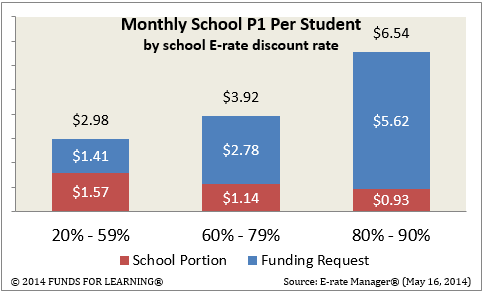On May 16, 2014, Funds For Learning® submitted our FY 2014 P1 Demand Analysis to the FCC, a report on current school spending for telecommunications services and Internet access. Our analysis was designed to help answer two fundamental questions:
- What do schools spend each year on telecommunications and Internet access?
- What drives cost variations between schools?
E-rate funding applications provide a clear window into school spending. But discovering the underlying factors that influence costs is a much harder question to answer. Over the course of the next month, Funds For Learning® will begin to tackle the questions above via a four-part series that dives deeper into our analysis, shedding light on the data and debunking several E-rate myths along the way.
Part 2 – Impact of Discount Rates on P1 Services
The schools serving the poorest communities in America pay an average of $0.93 per student each month for P1 services (telecommunications and Internet access). Leveraging the E-rate discount program, these schools receive monthly telecommunications and Internet services valued at $6.54 per student.
Schools serving the wealthiest communities pay an average monthly bill of $1.57 per student for P1 services. Including E-rate discounts, these schools use, on average, $2.98 per student in monthly telecommunications and Internet access.

The range of monthly out-of-pocket expense per student only varies a small amount, from $1.57 down to $0.93 per student; however, because of the E-rate discount matrix, the schools serving the most economically disadvantaged families are able to receive a much higher-value service.
Looking at monthly out-of-pocket expense by location shows a smaller difference. City schools pay an average of $1.04 per student each month. Rural schools pay $1.36 per month.
NOTE: These charts do not include the data for New York City Board of Education or Remote Rural Alaska schools.
Conclusion
School out-of-pocket expenses do not vary significantly based on the discount rate of applicants. No matter the discount rate, or the location of a school, you can expect that it is probably paying between $1.00 and $1.50 per student each month for telecommunications and Internet access. The E-rate program discount matrix simply allows schools serving the poorest families to multiply their buying power to receive a higher value service for their schools.
Next Week: Part 3 of our analysis will look at the impact of school size on telecommunications and Internet access expenditures.
#####
Below are tables showing the average annual per student expenditures by discount rate and location. The tables show the total value of services received, the school out-of-pocket expense, and the amount of E-rate discounts requested per student. Annual and monthly numbers are provided for convenience.
